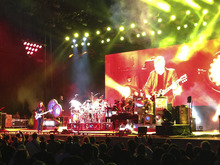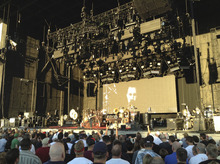This is an archived article that was published on sltrib.com in 2013, and information in the article may be outdated. It is provided only for personal research purposes and may not be reprinted.
Three songs into Rush's set Wednesday night at the USANA Amphitheater, singer Geddy Lee joked that the band had "600 or 800" songs to play for the audience.
Or, at least it seemed like a joke. But with Rush's history and famously long sets, I wasn't quite sure. Maybe they were just going to play everything?
That didn't happen, but Rush did essentially play three distinct shows: a straight forward rock concert, a steampunk opera, and spacey encore. And while Rush is nothing if not polarizing, the show proved that sometimes rock is at its best when it's at its biggest and most spectacular.
The show began at precisely 8 p.m., when a black sheet fell from Neil Peart's copper and gold drum set. In rapid succession falling sheets revealed a keyboard that looked more like a massive watch gear, a set of three giant magnifying glasses, and a machine that looked like the work of a mad scientist with an interest in gramophones. Rush's Clockwork Angel's tour — in support of their recently-released album of the same name — was apparently a steampunk fantasy.
Despite the set pieces, the first third of the show was decidedly traditional. When the band began with "Subdivisions," the most striking thing was how much Lee's voice had dropped over the years.
I'm not going to lie, I've always had a lot of respect for Rush's technical skills, but coupled with some skepticism of drum solos. And Lee's slightly-too-epic voice.
So the vocal drop was welcome. It meant that through the next handful of songs — which included "The Big Money," "Grand Design," "Limelight" and others — the band's most polarizing feature was basically a non-issue.
If the show had ended after the first batch of songs it would have been a decent rock concert from an older band. As my Rush-fan friend Landon noted, it also included a larger range of material and was less of a "greatest hits" performance than some previous Utah shows.
After a short intermission, however, we learned that the show was just getting started. Though Lee claimed the intermission was needed because the band members are "a million years old," it actually seemed timed to coincide with the sunset; when the music resumed, the band unleashed an arsenal of strobe stage lights and a corps of string players joined the band onstage.
An early high point of the post-intermission set came during "Carnies." The stage was already awash in flashing lights but suddenly it exploded, literally; a row of torches ignited behind the band and fireworks zipped through the air. All the while the steampunk theme of the set pieces was teased out in a series of loosely connected imagery and animation on the screen.
The performance was baroque in spirit and Victorian in style. It was also a welcome throwback to an era in rock that valued spectacle and bombast, when musicians said, "hell yes, we always want more lights, more string players, and louder sound systems. Let's crank this mother to 11."
The energy, or at least the spectacle, tapered off somewhat as the set continued, unfortunately. Through a series of more recent songs the lights became dimmer and the fire all but disappeared. The spectacle ramped up later during "Red Sector A," but it never quite reached that early zenith again.
But that's nitpicking because, after all, what can you really say about a band like Rush that hasn't already been said? Is there anyone who doesn't have an opinion about them now? Is there such a thing as a "bad" Rush show at this point?
Probably not. Or at least, there was no evidence of it Wednesday night at USANA. The band members showed that they were consummate professionals who delivered more than was expected. They were indefatigable and showed what, once upon a time, rock and roll was really like. —
Rush at the USANA Amphitheater
Who • Canadian prog rock legends Rush stop in Utah for their Clockwork Angels tour.
Where • USANA Amphitheater
When • Wednesday, July 31





